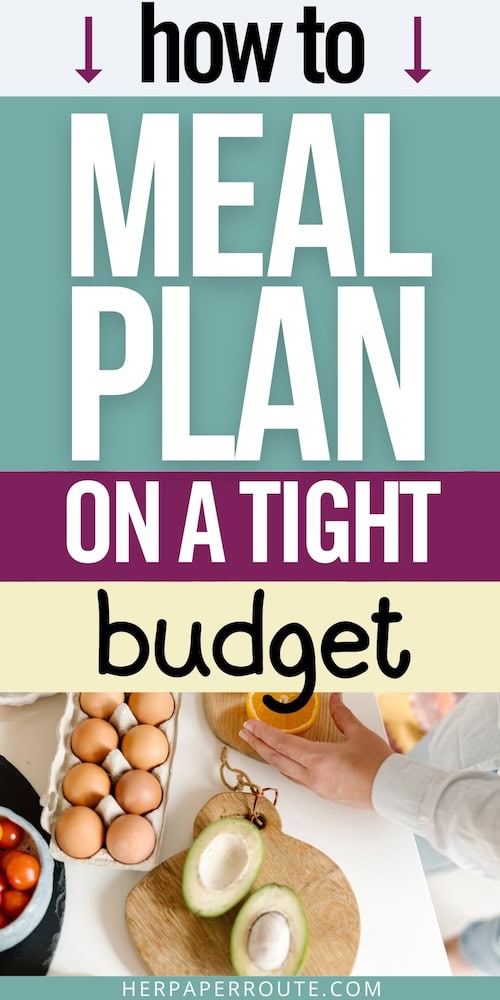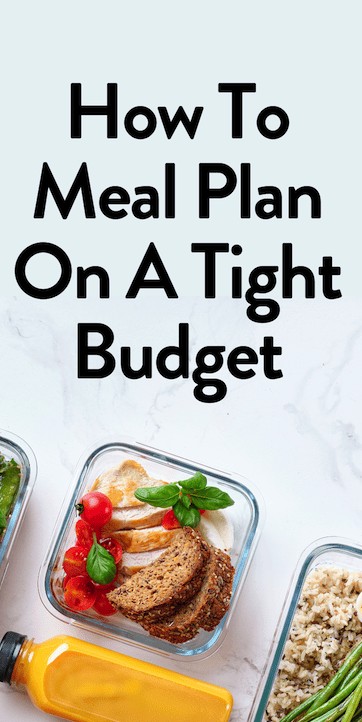How To Meal Plan On A Tight Budget

If you are curious about how to meal plan on a tight budget, look no further. Meal planning is supposed to save you time and money, but done wrong, it can actually cost you more.
If you have a small budget, it’s essential to know how to meal plan properly so that you can save money and still feed your family. Aimlessly wandering down the grocery store aisles and grabbing whatever looked good at the time is not a good way to shop.
As an affiliate partner of various brands and sponsored content, HerPaperRoute may earn commission on qualifying purchases. Disclaimer
Even worse, grocery shopping before eating meals lowers your impulse control so you spend even more. A simple grocery trip can easily blow your $200 budget.

11 Essential Tips For Meal Planning On A Tight Budget
It has taken a while but I have found a system that works for my family that I wanted to share with you. Below I go over meal planning on a tight budget that will save you lots of money.
The following steps will walk you through the process of how to meal plan on a small budget.
These tips will show you how you can save money on food and how to plan out your weekly meals.
If you’re not sure what your grocery budget should be, check out these food budget averages for a good starting point.
1) Know What Food You Already Have
Make a list of the items in your pantry, fridge, freezer, and deep freezer. Now is a great time to get rid of the ketchup from five years ago and expired applesauce.
You may even discover that you have a lot more storage containers than originally thought as you find leftovers shoved to the back of the fridge. By looking through the food you currently have, you’ll be able to make sure you’re not buying duplicates of food you already have plenty of.
Cleaning out the fridge also lets you assess which meals were forgotten about after being made. Even when money is tight, you want to enjoy the food that you’re eating.
2) Eat The Food That Is There
Heard of the saying “eat through your pantry?” Pantries are spacious and great for storing a large number of nonperishables.
Unless it’s hurricane season or you’re storing your season’s canned garden wares, there’s no reason to have a large stockpile of food.

Biologically we are wired to want to store food and stock up in case hard times come. Much like gaining weight in the winter, it is a self-preservation tactic for when resources are low. Stored food equals stored energy and increases survival rates.
With all of our modern conveniences, like grocery stores where you can buy bananas year-round, there is no longer a need to have large amounts of food collecting dust in the pantry.
Making recipes that specifically target the ingredients you already have on hand will keep your grocery list much smaller. Another bonus is that you won’t accidentally forget about the pantry items until after they’re expired.
3) Make A Mini Grocery List
Your first month’s grocery bill may be low since you’re consuming food you already have. Only purchase supplemental items that assist in using up the food you already have.
Your grocery list could include cilantro and lime to make a pot of cilantro-lime rice with the rice you have in the cupboard, for example.
Clearing out the current food clears the mental block and is a fresh start. You’re probably used to opening the pantry, seeing the same can of beans, and thinking to yourself that there’s nothing to eat so you’re ordering a pizza.
An empty pantry is a blank slate you can fill with intentional items that are budget-friendly.
4) Decide What To Buy In Bulk
Part of meal planning is to write out the grocery list. Some items are better to buy in bulk, especially if you’re a member of a warehouse store like Costco.
If sandwiches are this week’s lunch then a bulk loaf of bread and tub of hummus may make fiscal sense. Other items such as rice and dried beans can be found in bulk at very cheap prices.
The key to buying in bulk is to go in with a list and make sure the item is something your family will use up before it goes bad.
5) Buy Only What’s On Sale
The weekly grocery fliers are a great way to see what the store specials are. Entire recipes can be planned around using only the items that are on sale this week.
6) Choose Inexpensive Foods
Some groceries are less expensive than others. Typically, meat, dairy, and fresh organic produce are the most expensive.
Instead, choose alternative less-expensive foods. Dried beans and lentils are a great source of protein for dinners. Oats are much cheaper than a box of cereal and is a filling healthy breakfast.
Even if you want to keep eating organic produce, frozen organic produce costs less than fresh and is equally as nutritious.
7) Have One Person Focus On Buying Groceries
If you’re in a couple, decide who will do the grocery shopping. Whether one person in the household plans the meals, makes the grocery list, and does the shopping or those tasks are split amongst a few people does not matter.
Play towards everyone’s strengths and you’re more likely to follow the plan. One person may be great at making lists but hates shopping. The reason for having one person focus on grocery shopping is so they can more easily keep track of the food budget.
Or you can use a service like Instacart to do your shopping for you. This is great if you’re short on time. It also pays for itself by preventing you from impulse purchasing in store.
8) Take Cash To The Grocery Store
I recommend taking the food budget money out in cash at each paycheck to use at the store. This assists with staying on budget and helps curb impulse spending.
Make a commitment that once the food budget money is spent, you’ll make do with what you have left in the house until the next paycheck.
9) Find Simple Recipes
Getting into the groove of meal planning is not the time to try out complicated recipes. Food is nourishment and not entertainment.
One-pot meals are easy to prepare which will be much easier to cook after a long day at work.
Writing the week’s meals on a whiteboard in the kitchen keeps it front of mind. It also cuts out the “What’s for dinner?” questions that everyone loves hearing multiple times a day.
10) Double Recipes
Another easy way to save money is to double up the recipe. Many times, recipes ask for half an onion or part of a vegetable broth. Often, what isn’t used gets forgotten about and goes bad.
Instead, double the recipe to use up the entire ingredient. You’ll have lots of leftovers to eat for lunch and the next night’s dinner which gives you a day off with cooking.
11) Meal Planning Going Forward
Once you’ve eaten through the food in your house, the next step is to plan out your meals and buy only what you need for the week. Meal plans don’t have to be complicated. Breakfast and Lunch can be sandwiches and simple to prepare foods.
- Breakfast = plain instant oatmeal with a dollop of peanut butter and a chopped banana
- Lunch = leftovers from prior night’s dinner or sandwich with a side salad
- Dinners especially don’t need to be complicated. It’s often unrealistic to expect to cook dinner 5 nights a week.
You had a long day at work, the kids needed to be driven to soccer practice, and the baby had a rough day of teething. No wonder why ordering takeout is so tempting.
By choosing your recipes and only getting enough food that you need for the week’s meals, you’re cutting down on the pantry stockpiling and food waste that would normally occur.
How Many Days Each Week Should You Cook?
It comes down to what you think is most sustainable for your family. Do you think you could cook dinner 3 nights a week? What about 2 nights? That is all the effort that is needed to have a meal plan and give your family home-cooked meals all week.
Doubling a recipe will give enough leftovers to reheat for dinner tomorrow. Every other day cooking is less daunting. The self-proclaimed “horrible cook” can even reheat food to take some pressure off the person who does the majority of the cooking.
How To Meal Plan On A Tight Budget – Conclusion
The more you meal plan, the easier it becomes. It’s okay to have weekly staples like pasta on Mondays and tacos on Friday. Growing up, my family rotated through around 10 recipes or so. I never thought twice about it or felt like I was being deprived. There’s comfort to be found in a routine and food is no exception.
Follow along on Instagram!










